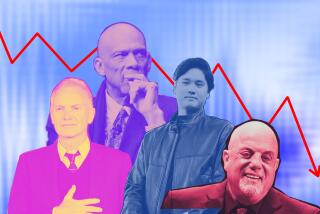The WSJ again wrings its hands over our struggling 1%

- Share via
In the latest example of a curious journalistic genre--the pain and suffering of the 1%--the Wall Street Journal asks us this weekend to commiserate with six-figure income-earners facing bankruptcy.
“Some high earners end up leading a lifestyle they can barely afford, saving little or nothing for retirement and living paycheck to paycheck,” the article says. It quotes a bankruptcy attorney in tony Southfield, Mich., saying, “Some people you wouldn’t expect are teetering on the edge of bankruptcy.”
The article’s theme is that even rich people can live beyond their means. Not really news. What’s insidious about reporting like this is that it asks us to commiserate with high-earners who run into financial trouble despite having the flexibility to deal with their situations that middle- and working-class families can only dream about.
Yet if you turn from the Journal’s news pages to its editorial page, you’ll find the latter being cursed for the moral turpitude, and the former getting the benefit of the doubt. If the Journal’s editorial writers read their news pages, they may discover that their reporters are undermining their usual argument that we need to safeguard the income of the “job creators” at the top of the economic pyramid by cutting income and benefits for the rank and file at the bottom.
The newest piece has the air of unreality, not to say irrelevance, typical of the genre. Its central character is Sylvia Flores, a San Diego-area businesswoman who was earning more than $200,000 a year before she “got into trouble” with her spending.
“She had a personal chef and a housekeeper, and took her husband and two children to Hawaii for frequent vacations,” we’re told. Having seen the light, “she started making her own meals, moved to a cheaper condominium, cut out expensive vacations and shopped for clothes at thrift stores.”
It turns out that Flores’ problem may run deeper than simply failing to live within her means this one time--she also ran into trouble in 2005, when she acquired $500,000 in debt and had to file for bankruptcy. Is she really representative of wealthy people unable to make ends meet, or of a different kind of economic pathology? The Journal doesn’t give us enough information to know.
There are other signs, however, that the Journal is placing its thumb on the scale. To break down how a wealthy family can go bust, the article asks us to “consider a hypothetical couple in the Chicago area making $400,000 a year.” (The most recent IRS figures say that adjusted gross income of $389,000 puts one in the top 1%.)
The article examines their hypothetical spending with the help of Northern Trust Wealth Management, a firm that supposedly knows this segment inside and out. The bank’s figures show the sample family to be “$10,000 in the hole every year.”
The sample couple lives in a home valued at more than $1 million. Northern Trust estimates their mortgage payments at $87,000 a year.
Stop right there. A $1-million 30-year mortgage would have to carry an interest rate of 7.875% to cost $87,000 a year. Is this plausible? Current figures from bankrate.com place the going rate for jumbo mortgages in the Chicago area at 4.14%.
Would this couple really not have refinanced? Plug the lower rate into the mortgage, and you’ve saved the family about $30,000 a year; suddenly, they’re back in the black. And that’s assuming that their mortgage is for the full $1 million, that they didn’t buy the house years ago for much less. (Of course, the house could have cost much more than $1 million, but that’s not what the article says.)
The article also doesn’t emphasize that mortgage interest is tax-deductible; if the mortgage is 10 years old, it could produce a tax break of $15,000-$25,000 per year--a break not available, certainly not on that scale, to a “hypothetical” lower-income household without a million-dollar home. The article also estimates “home maintenance” at more than $2,000 a month, which sounds pretty high unless we’re talking about a million-dollar fixer-upper.
And it glosses over much of the hypothetical couples’ other expenses, which include club dues, about $400 a week in fine dining and entertainment, a $60,000 new car every four years. These are expenses, of course, that most American families can’t shoulder at all and that even for a wealthy couple are frills that can be dispensed with. There’s also $22,000 a year in savings for retirement and college, which the typical family can’t manage unless it’s wealthy.
Articles like this fall into the category of reverse econ-porn. They offer the chance not to salivate over the lifestyles of the rich and famous, but to chortle over their heedlessness and stupidity. Fine: give us this glimpse into how high earners can spend their way to ruin. Just don’t ask us to feel sorry for them.
Keep up to date with The Economy Hub by following @hiltzikm.
More to Read
Inside the business of entertainment
The Wide Shot brings you news, analysis and insights on everything from streaming wars to production — and what it all means for the future.
You may occasionally receive promotional content from the Los Angeles Times.











